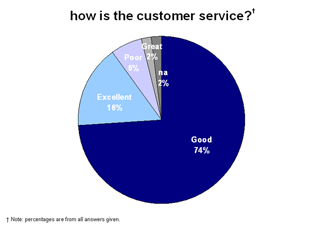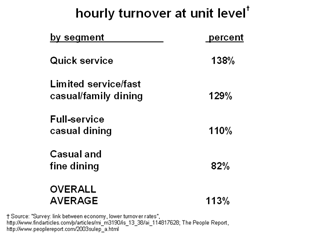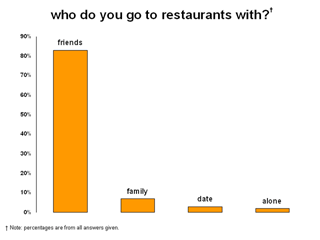management
There's an International House of Pancakes in my backyard. I'm on first name basis with every waitress there. They don't even give me the menu anymore and bring me my regular drink upon seating me. (Sometimes, they'll even tell me to seat myself.) This IHOP is unusual in its industry because everyone thinks of themselves as family. They hang out after work, give each other rides back home, and even more interesting, effortlessly chat with customers. This can't be training. (Maybe it is, because unfortunately, it pressures me into being a big tipper.) In an industry that regularly replaces its entire staff-per-restaurant 1.3 times annually (1), this is indeed a small miracle of human nature. And it also keeps me spending on the awful food despite all the surrounding alternatives.
The question of whether or not the industry is saturated is not a question when the service is exceptional. With so much competition, can a restaurant not afford to kiss my @ss? A recent al berrios & co. study on Consumers' Thoughts on Dining Out revealed that with so many locations, 94% of consumers feel that their favorite restaurant is easy to get to. And even though turnover is high, customers service levels are at an all time high and average number of years visiting is 2.7 (2).



It appears that current
employee turnover levels are ok. Any higher, and the likelihood that your employees
will come to like each other enough to like customers, too, will decrease.
But
when employee turnover gets lower, much like my IHOP, and the likelihood that
they'll like each other increases, the likelihood of turning your customers
into repeat customers or "regulars" is assured (along with your financial
success).
The key to customer retention in the restaurant industry is clearly
developing a recruitment and retention program for employees that foster an
environment conducive to exceptional customer service.
To support natural friendliness
as the most powerful strategic driver of internal restaurant growth, consider
that according to our study, 69% of consumers were introduced to their favorite
restaurant by a friend; 90% go with friends or family. When your customers arrive
at your restaurants, they're in a naturally friendly state of mind. Imagine
that shattered by an anti-social, introverted employee, who just wants to leave?
Granted, there are difficulties in finding such exceptional, naturally friendly
people and supporting so many of them on such tight margins, however, it is
not impossible. A greater challenge is instilling natural friendliness in your
current workforce. But at your rate of turnover, effects of your changes should
be painless and noticeably fast.
The greatest challenge will be in managing this shift in your customer-retention
strategy among franchisees. But by presenting them with the compelling argument
that groups of two-or-more people spend an average of 14% more on food-away-from-home
than the national average (3), it's ultimately in franchisees
best interest to alter their mindset to accommodate and instigate the social
interaction for which their restaurants are such an apparent draw.
Write to
Al Berrios at editor@alberrios.com
Top
Footnotes
(1) 36,500,000 workers divided by 878,000 restaurants in 2003, multiplied
by 129% turnover. Source: U.S. Department of Labor, Bureau of Labor Statistics,
Bureau of Labor Statistics Data; National Restaurant Association
(2) al berrios & co. analysis
(3) al berrios & co. August 2004 Study on Consumers' Thoughts on Dining Out
Top
Related al berrios & co. articles
- "al berrios & co. August 2004 Study
on Consumers’ Thoughts on Dining Out"
- "Cooking Less"
Top
Related alberrios.com Sections
- Our latest thinking on the restaurant industry
- Our coverage of retail brands
- Our research
on the retail industry
- Our latest thinking on consumer perceptions
- Our analyses of the latest thinking in the
retail industry
- Learn
more about the retail + restaurant
industries
- Consumer
advocacy
- News about
the retail industry
Top
Disclaimer:
The recommendations, commentary and opinions published herein are based on
public information sometimes referenced via hyperlinks. Any similarities or
likeness to any ideas or commentary from any other sources not referenced
is purely coincidental. al berrios & co. cannot control any results occurring
from advice obtained from this publication nor any opinion(s) conveyed by
any reader of this publication.
al berrios & co. does and seeks to do business with companies covered
in its research reports and studies. As a result, the reader should be aware
that the firm may have a conflict of interest that could affect the objectivity
of this report or study. Readers should consider this report or study as only
a single factor in making any strategic or investment decisions.
(c) 2001-2005. All Rights Reserved. al berrios & company, inc. Published by al berrios & co. This Report may not be reproduced or redistributed in any form without written permission from al berrios & co., subject to penalty.